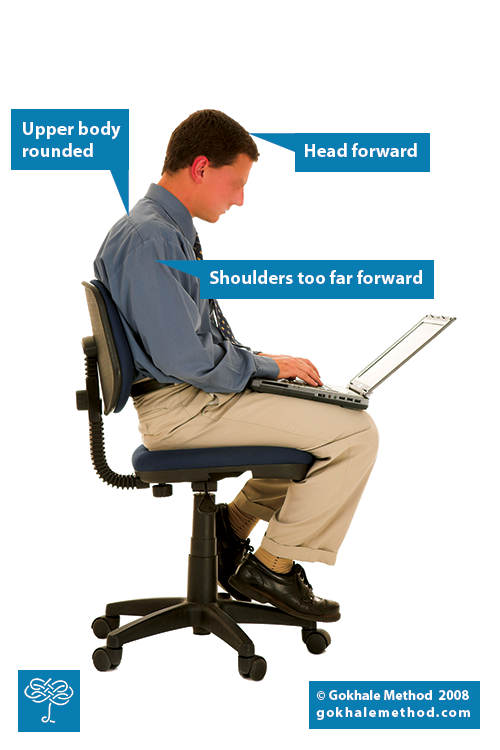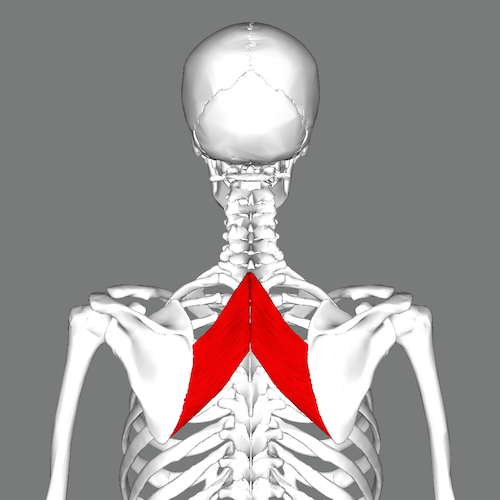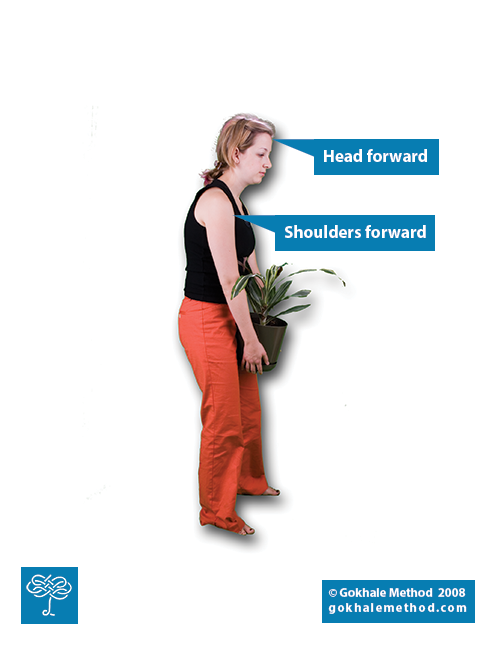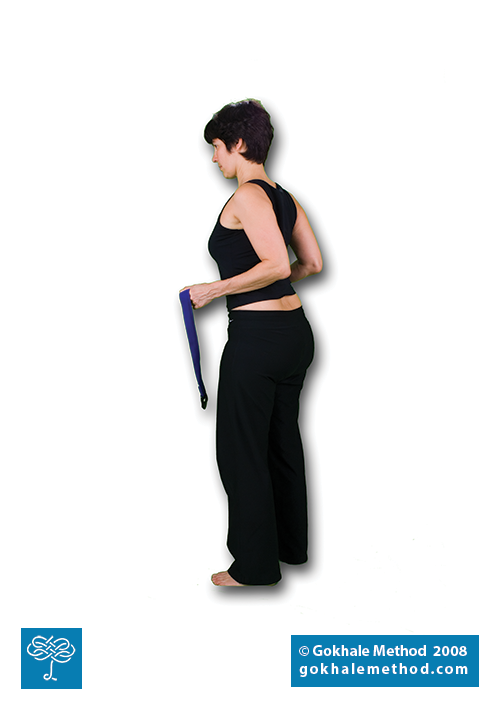When Is It Good to Pull Back Your Shoulders?
This is the second post in our series on shoulder positioning. Read Part 1 here!

Typing with shoulders too far forward.
Often, in industrialized cultures, the shoulders are slumped or held forward. There are so many daily tasks in the modern world that make it all too easy for these bad habits to set in: holding our arms out front for hours with poor shoulder placement while we are typing, gaming, driving, and so on. Over the years this is likely to cause various problems:
Impingement, bursitis, wear-and-tear
Reduced circulation to the arms
Compromised breathing patterns
Reduced athletic performance, increased injuries
Hunched upper back and forward head
Common pitfalls in getting the shoulders back
Unfortunately, well-intentioned advice such as “pull your shoulders back” often has negative consequences. When we try and correct our shoulder position by pulling back, we are likely to either tense and sway our lower backs, or tighten the rhomboid muscles between our shoulder blades — or both! Neither of these responses are healthy or comfortable for very long.
Meet the rhomboids
The rhomboids, which pull the shoulder blades together, are not designed to be squeezed tightly for long periods. If you consistently rely on them to pull your shoulders back, they can become sore, knotted, and inflamed

The rhomboids are not designed to be squeezed tightly for long periods. Original image courtesy Wikimedia user Anatomography under CC BY-SA 2.1 jp.
Those of you familiar with the Gokhale Method are probably already practicing the shoulder roll. This gentle movement brings the shoulders home to a naturally sustainable position. For detailed tips on refining your shoulder roll, please see my recent blog post on shoulder positioning.
Though the rhomboids should not be continuously contracted when you are upright, they exist for good reason. The rhomboids play an important role in keeping the shoulder joint stable, especially when you bend forward, carry heavy objects, or reach for something in front of you. These actions would otherwise displace the shoulders forward.

Inactive or weak rhomboids allow the shoulders to be pulled forward when carrying loads in front of the body.
Changing lifestyles

This farmer doesn’t bring his shoulder forward to carry his watering can.

This Burkinabé teenager pounds millet with her shoulders staying far back.
Our ancestors, like people in traditional and non-industrialized cultures today, had many more opportunities in daily life to use their rhomboids and upper back muscles: drawing water, clearing land, sweeping the yard, and harvesting crops. We can get much of this conditioning from sport such as rock climbing, games such as tug-o’-war, and chores such as gardening or vacuuming, but suitable activity may not continue into a more sedentary adult life. Without regular challenges, the muscles of the upper back can become weak and lax, allowing the shoulders to drift forward and the upper back to round.
Rhomboid toner exercise
Exercises are useful to isolate and strengthen muscles that have been systematically under-used. I find the rhomboid toning exercise below to be effective.

- Hold a physical therapy band or strap. Keep your wrists straight, palms facing up.
- Begin by performing a shoulder roll. This healthy shoulder position places your rhomboids in a position of mechanical advantage.
- Pin elbows to your sides at a 90º angle. The position is similar to when you’re carrying a tray.
- Draw your shoulder blades as close together as you can. Your hands will move away from each other. The band or strap provides resistance to this motion, challenging the rhomboids. Be sure not to tense the shoulders or neck.
- Hold for a few seconds. Repeat 5 to 10 times.
Getting your rhomboids to work for you when you need them will benefit both your shoulder health and your posture. Next time you are carrying heavy bags or pulling a door towards you, notice how these muscles help to preserve your shoulder position. Sometimes a little pulling back goes a long way!

Comments
It took several years of
It took several years of posture consciousness before I could get my shoulders back down and relaxed. I needed to overcome the forward head and tight pecs. An exercise that made a difference was sitting at the base of a wall, with legs straight out. This exercise stretches the entire posterior chain and flattens excessive cervical curvature.
I sat as close as I could to the wall, pulling shoulders back and keeping chin low and tucked. I would keep this position while watching TV, or saying my rosary. I now, thanks to the Gokhale method have exceptional posture. I am 59.
Thank you so much, your book and videos have profoundly changed my health. I think you should make a documentary available on Netflicks so millions of people would be exposed to native posture.
So glad to hear about your
So glad to hear about your trajectory - congratulations! We're trying our best to get the word out. One challenge we have faced with larger organzinations picking us up is that we don't have many social media followers! If you're reading this, please consider Liking / Friending / posting on our various pages in the public domain.
2 things that help me- Oddly,
2 things that help me
- Oddly, I find clothing encourages rounded shoulders. So I use that to my advantage. I wear T-shirts bkwd. They encourage a shoulder back position, and the neckband at my neck reminds to keep head erect.
- My posture thought is not shoulders back; can't maintain that for long. But "sternum pointing up", seems to roll shoulders back automagically.
Esther, your thoughts?
Wow. That's an extreme
Wow. That's an extreme example of the material world reflecting and perpetuating our deterioriating posture. If the manufacturers of your clothing have indeed turned the clothes around to fit a slumping upper body, then this is a clever solution to be guided the other way. Most of my T-shirts are symmetric front to back - also not ideal but there wouldn't be anything gained from turning then back to front. We do indeed live in a bit of a topsy-turvy world!! All the more reason to get a threshold nmber of us clued in to healthy posture and driving the market back to a healthy state.
Wanna strengthen those
Wanna strengthen those rhomboids, and do something creative, beautiful, and useful at the same time? Carve a spoon! The "chest lever stroke" is perfect exercise, and beautifully illustrated by master carver Jogge Sundqvist, at about 4:40 in this video. It's also a safe, effective, and controlled way to use a sharp knife. I can't say all spoon carvers have good posture, or even shoulder position, but if they use this stroke, I bet their rhomboids are toned!
Add New Comment
Login to add commment
Login